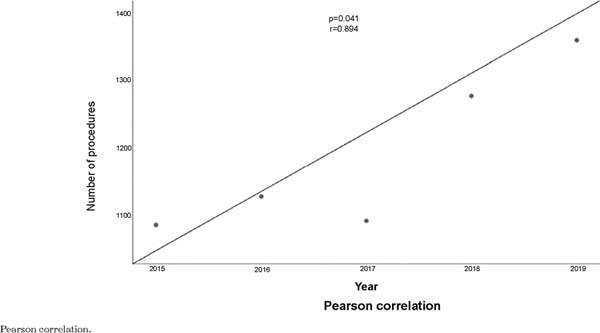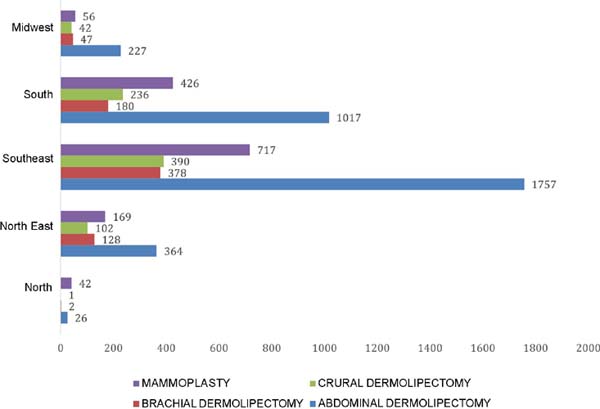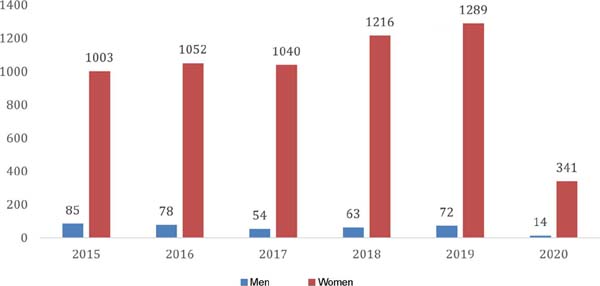

Original Article - Year 2023 - Volume 38 -
Analysis of post-bariatric plastic surgeries performed in the Brazilian Unified Health System
Análise das cirurgias plásticas pós-bariátricas realizadas no Sistema Único de Saúde
ABSTRACT
Introduction: Obesity and overweight have been increasing in Brazil and in the world, in an expressive way, as well as the demand for bariatric surgeries. As a result, post-bariatric plastic surgery has also grown, especially abdominal dermolipectomy. The objective is to describe the frequency of post-bariatric plastic surgeries performed by the Unified Health System (SUS - Sistema Único em Saúde, in portuguese) from January 1, 2015 to October 21, 2020.
Methods: Ecological study, where individuals who underwent post-bariatric surgeries were selected. bariatric tests by SUS obtained by the Hospital Information System of Department of Informatics of the Unified Health System (DATASUS - Departamento de Informática do Sistema Único de Saúde, in portuguese). Data from the 27 states of the national territory were analyzed and the following variables were used: gender, age group, procedure performed, level of education.
Results: The southeastern region of the country had the highest number of post-bariatric surgeries. White individuals, on the other hand, had higher numbers than other races (60.9%), abdominal dermolipectomy was the most frequent (53.7%) followed by mammoplasty (22.3%).
Conclusion: Plastic surgeries have increased significantly in the last five years, and are more frequent among white women, aged between 35 and 44 years, living in the southeastern region of the country.
Keywords: Obesity; Bariatric surgery; Abdominoplasty; Weight loss; Reconstructive surgical procedures; Unified Health System
RESUMO
Introdução: A obesidade e o sobrepeso vêm aumentando no Brasil e no mundo, de uma forma expressiva, assim como a procura por cirurgias bariátricas. Em consequência, a cirurgia plástica pós-bariátrica também cresceu, com destaque para a dermolipectomia abdominal. O objetivo é descrever a frequência das cirurgias plásticas pós-bariátricas feitas pelo Sistema Único de Saúde (SUS) no período de 1 de janeiro de 2015 a 21 de outubro de 2020.
Método: Estudo ecológico, no qual foram selecionados indivíduos que realizaram cirurgias pós-bariátricas pelo SUS obtidos pelo Sistema de Informações Hospitalares do Departamento de Informática do Sistema Único de Saúde (DATASUS). Foram analisados dados dos 27 estados do território nacional e utilizaram-se as variáveis: sexo, faixa etária, procedimento realizado, grau de instrução.
Resultados: A Região Sudeste do país apresentou maiores números de cirurgias pós-bariátricas. Já indivíduos da cor branca apresentaram números maiores do que outras raças (60,9%); a dermolipectomia abdominal foi a mais frequente (53,7%), em seguida, a mamoplastia (22,3%).
Conclusão: As cirurgias plásticas tiveram aumento expressivo nos últimos cinco anos e são mais frequentes entre mulheres, brancas, com faixa etária de 35 a 44 anos, residentes na Região Sudeste do país.
Palavras-chave: Obesidade; Cirurgia bariátrica; Abdominoplastia; Redução de peso; Procedimentos cirúrgicos reconstrutivos; Sistema Único de Saúde
INTRODUCTION
Obesity and overweight have been increasing in Brazil and worldwide. These comorbidities are considered by the World Health Organization (WHO) to be a global epidemic caused mainly by inadequate diet and sedentary lifestyle1. In Brazil, in 2018, about 55.7% of the adult population was overweight, and 19.8% was obese2. In this context, the demand for bariatric surgeries has increased, which was even more expressive within the Unified Health System (SUS -Sistema Único em Saúde, in portuguese).
Between 2001 and 2014, 49,425 bariatric surgeries were performed by SUS. Bariatric surgery is considered the most effective long-term treatment to control obesity, resulting in significant weight loss. About a year after bariatric surgery, patients can lose about 45% of their initial weight, which leads to the remnant of considerable excess skin, which results in marked sagging3.
The abdomen is one of the places most affected by post-bariatric weight loss and can cause discomfort to patients, such as difficulties with personal hygiene, social interaction, or even damage to intimate life, reduced self-esteem, and distortions in body contour. These impacts can be corrected or minimized through plastic surgeries that, in addition to the aesthetic advantage, significantly improve the quality of life of patients4.
In recent years, demand for post-bariatric plastic surgery has grown, with an emphasis on abdominal dermolipectomy – also known as abdominoplasty. A study indicates a frequency of 76.97% of abdominoplasties and 42.46% of mammoplasties in a public hospital in the Federal District5. Moreover, the average time between bariatric surgery and plastic surgery was 42 months.
Such surgeries aim to minimize the consequences secondary to bariatric surgery and demonstrate a positive impact on the patient’s quality of life. Because of the high prevalence of obesity and the demand for post-bariatric plastic surgery, the importance of this topic for the medical field and its impact on the SUS is highlighted.
OBJECTIVE
Therefore, the present study aims to describe the frequency of post-bariatric plastic surgeries performed by SUS from January 1, 2015, to October 21, 2020.
METHOD
This is an ecological time-series, observational and descriptive study, with individuals who underwent post-bariatric surgeries by the SUS from January 1, 2015, to October 21, 2020, carried out in the city of Lauro de Freitas, Bahia, following the principles of Helsinki. Data were obtained by the Hospital Information System (SIH) of Department of Informatics of the Unified Health System (DATASUS - Departamento de Informática do Sistema Único de Saúde, in portuguese).
The collection was carried out on 10/22/2020 through TABWIN, a program for local analysis of the Sinan Net database, which allows the import of tabulations made on the Internet (generated by the TABNET application, developed by DATASUS and used on the Information page of Health of this site), using the abdominal, brachial and crural dermolipectomy procedures after bariatric surgery and mammoplasty after bariatric surgery, from 2015 to 2020, analyzing the compulsory notifications through the variables of race, sex, suicide attempt, age detailed, occupation, medications, and municipality.
Data analysis will be presented by tables and graphs organized using the Microsoft Excel 2019 software. In this study, data from the 27 states of the national territory were analyzed, and the following variables were used: gender, age group, the procedure performed, and level of education. Pearson’s correlation analysis was performed using the Statistical Package for the Social Sciences software (SPSS inc., Chicago, IL, USA) version 14 for Windows. For statistical inferences, p<0.05 was adopted.
RESULTS
Within the analyzed period, a total of 6307 procedures were performed by the SUS. Figure 1 demonstrates an increase in procedures until 2019; in 2015, there were 1088 surgeries, and in 2019 there was an increase of 25.09%, totaling 1361 procedures. There was a positive linear correlation (r 0.894), significant (p=0.041) when comparing the years 2015 to 2019 (Figure 1).
In Table 1, the white race had the highest prevalence in all years analyzed, followed by brown and black races. However, there was a large number of people who did not know how to inform about their race during this study period. Abdominal dermolipectomy is the most frequent procedure (53.7%), followed by mammoplasty (22.3%).
| Variables | Absolute number (%) |
|---|---|
| Color/race | |
| White | 3842 (60.9%) |
| Brown | 1637 (21.6%) |
| Black | 206 (3.2%) |
| Yellow | 54 (0.8%) |
| Indigenous | 1 (0.01%) |
| No information | 567 (8.9%) |
| Total | 6307 (100%) |
| Procedures performed | |
| Abdominal dermolipectomy | 3391 (53.7%) |
| Brachial dermolipectomy | 735 (11.6%) |
| Crural dermolipectomy | 771 (12.2%) |
| Mammaplasty | 1410 (22.3%) |
Table 2 presents the frequency of plastic surgeries according to the region among the studied age groups. The country’s Southeast Region had the highest number of post-bariatric surgeries in adults between 40 and 59 years old, as well as a higher frequency of surgeries in the general population (Figure 2).
| Region | 10-14 years | 20 -39 years | 40 - 59 years old | Over 60 |
|---|---|---|---|---|
| North Region | 1 (20%) | 35 (1.5%) | 33 (0.9%) | 2 (0.4%) |
| Northeast Region | 1 (20%) | 334 (15.1%) | 381 (10.6%) | 46 (9.0%) |
| Southeast Region | 3 (60%) | 1088 (49.2%) | 1851 (51.7%) | 300 (58.7%) |
| South Region | 0 (0%) | 626 (28.3%) | 1087 (30.3%) | 146 (28.5%) |
| Midwest region | 0 (0%) | 128 (5.7%) | 227 (6.3%) | 17 (3.3%) |
| Total | 5 (100%) | 2211 (100%) | 3579 (100%) | 511 (100%) |
In 2020, data available by TabWin up to October 22 were analyzed. Until the writing of this article, there was no update of this data in the system, with a partial total of 355 procedures performed.
Figure 3 shows the frequency of abdominal dermolipectomy by sex according to the processing year; 5941 were women, and 366 were men. In all the years analyzed in the present study, the procedure was performed more among females.
DISCUSSION
The present study showed an increase in the frequency of plastic surgeries after bariatric surgeries performed by the Unified Health System. When evaluating the five regions of Brazil, a large numerical difference in the number of surgeries performed between the South and Southeast compared to the other regions is notable. This is due both to factors of population size and also because these regions are great centers of technological reference, specialists from different areas of health and hospitals. The states representing the Southeast and South regions have a higher concentration of plastic surgery specialists registered with the Brazilian Society of Plastic Surgery (SBCP), with 60.4% of the surgeons registered in the Southeast Region and 16.8% in the South Region in 20146.
Analyzing these data, we noticed that the Caucasian race has a greater aesthetic and functional concern concerning other races after bariatric surgery. This hypothesis arises from the higher frequency of white individuals undergoing surgery after bariatric surgery, corroborating other studies3,7. With surgical intervention, these individuals can acquire a higher level of satisfaction and improve their quality of life since removing excess skin and flaccid skin reduces the psychosocial repercussions that affect the lifestyle of these patients5. The present study shows that, out of every ten plastic surgeries, seven are performed on patients of color or white race (70%). Only 20% of brown people, 7% of black people, and 3% of yellow people. Mentions of indigenous people did not reach 1%.
According to the analysis performed on the frequency of dermolipectomy by age group, it is observed that there is a higher frequency of the procedure in the adult population (40-59 years), followed by young adults aged between 20 and 39 years, corroborating a previous study5. Concerning bariatric surgeries, on average, patients are 41.4 years old, have a body mass index of 48.6kg/m2, 21% are men, 61% are hypertensive, 22% are diabetic, and 31% have sleep apnea3. It is data of important correlation with our study.
However, when we analyze the frequency of plastic surgery according to the gender variable, a higher prevalence of females can be seen, corroborating the literature4,7,8. This fact can probably be theorized due to men’s prejudice towards acceptance of plastic surgery, in addition to abdominal flaccidity being more pronounced in some women, making them seek this intervention, in addition to the beauty standard imposed by society being more targeted for women9.
In patients after bariatric surgery, the consequence of great weight loss is skin sagging, which can be present in different body regions, frequently in the abdomen and breasts10,11. The study by Fernandez et al.9 demonstrated a high mean of abdominal circumference and waist measurement in obese patients (waist circumference value above 80 cm), which can generate a large accumulation of skin after bariatric surgery9. The accumulation of skin and flaccidity in these regions may explain the higher frequency of abdominal dermolipectomy and mammoplasty observed in the present study.
In this way, the importance of the present study is demonstrated to describe the scenario of post-bariatric plastic surgery in the Unified Health System. Because it is a descriptive ecological study, it has limitations regarding data collection and underreporting in the sources of data records. Therefore, multicentric cross-sectional studies are encouraged to obtain more information about the population profile that seeks this procedure and determine the impacts on public health.
CONCLUSION
Post-bariatric plastic surgeries are more frequent among white women between 35 and 44. As Brazil’s center of technology and urbanism, the Southeast consequently had the highest numbers of post-bariatric surgeries, probably due to the pace of life, technology, available human resources, and ease of access to health services in this region.
1. União Metropolitana para o Desenvolvimento da Educação e Cultura, Lauro de Freitas,
BA, Brasil
Corresponding author: Amanda Queiroz Lemos União Metropolitana para o Desenvolvimento da Educação e Cultura (UNIME). Av. Luis Tarquínio Pontes, 600, Lauro de Freitas, BA, Brazil. Zip code: 42700-000 E-mail: aq.lemos@hotmail.com











 Read in Portuguese
Read in Portuguese
 Read in English
Read in English
 PDF PT
PDF PT
 Print
Print
 Send this article by email
Send this article by email
 How to Cite
How to Cite
 Mendeley
Mendeley
 Pocket
Pocket
 Twitter
Twitter